| Web
and Book
design,
Copyright, Kellscraft Studio 1999-2017
(Return
to Web
Text-ures)
|
 (HOME)
|
|
CHAPTER I. QUEENSTOWN, CORK, AND BLARNEY QUEENSTOWN has been called a mere appendage to its harbour, and, truly, it is a case of the tail wagging the dog, though the residents of Cork will tell you it is Cork Harbour, anyway, and Queenstown is nothing but a town that was made by the American War of Independence, and by the emigration rush that, during the past sixty years, has deprived Ireland of more than half her population. Be this as it may, the harbour dwarfs everything else about the town. Above the enormous expanse of sheltered water, the little town piles itself up on the overhanging cliffs, pink houses, yellow houses, white houses, like a veritable piece of Italy. It is always warm here, or almost always. In the winter time, the temperature is seldom severe, and, in the summer, it is one of the finest yachting centres in the United Kingdom. The “Beach” of Queenstown is truly Irish, since it is not a beach at all, but a fenced street full of shops, occupying the place where a narrow strand once ran. Time was when Galway was a rival to Queenstown for the honour of being the link which was, by the emigrant chain, to bind the Old World to the New; but now the honour is Queenstown’s alone. If tears, — the bitterest ever shed on earth, the hopeless tears of lonely aged parents parting from their cherished offspring; of man’s love leaving woman’s love thousands of miles behind across the seas; of friend clasping the hand of friend perhaps for the last time; of brothers and sisters parting from brothers and sisters, and all from the land that the Irishman loves as he loves his own life, — if such tears as these could quench the myriad of fairy lights that sparkle on the great harbour at dusk, Queenstown would doubtless be the darkest city in all the world.
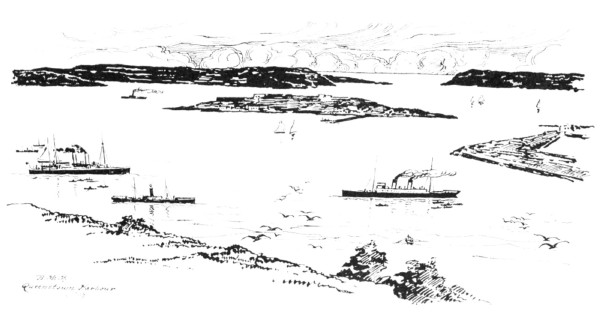 QUEENSTOWN HARBOUR. Queenstown is drenched in tears; the air still quivers inaudibly with the wailings that have filled it through day after day of half a century or more of bitter partings. Thousands have left Ireland every year from these quays, “the torn artery through which the country’s best blood drains away year by year.” To see an emigrant-ship cast loose from the quay and steam out of the harbour is a sight, once witnessed, that will never be forgotten; that will haunt one’s very dreams in years to come. Until 1849 Cove was the name of the city, but during a visit of Queen Victoria here at that time, her first visit to Irish soil, the name was changed, in her honour, to that which it now bears. Cork Harbour, to most travellers, is little more than a memory; but, in reality, it is one of those beautiful landlocked waterways which, for sheer beauty and grandeur, is, in company with Bantry Bay and Dingle Bay, which are less known, only comparable to the fiords of Norway. They have not the majesty or expansiveness of many of the latter; but they have most of their attributes more subtly expressed. Indeed, Cork Harbour and the river Lee, whose waters are in part enfolded by “the third city of Ireland,” Cork (Corcaig, “a marshy place”), are unapproachable in all the world for a certain subtle charm which is perhaps inexpressible in words. As the Lee divides and encircles the city, it well illustrates Spenser’s lines: “The spreading Lee that like an Island Fayre, Encloseth Cork with his divided flood.” Even the present-day aspect of Cork Harbour and the estuary of the river Lee from the heights of Queenstown is one of the fairest blendings of sea and shore anywhere to be seen. Spike Island, with its convict establishment; Haulbowline, with its naval establishment; Rocky Island, with its powder magazine; Crosshaven Ring; and Rostellan Castle at once attract notice; and the eye roams with pleasure over a charming scene, enlivened with shipping of all kinds and from all ports, from the humble lugger to the steam-collier, and, finally, the ocean leviathans, which, in our strenuous times, have become known as “record-breakers.” Into Cork Harbour Sir Francis Drake retreated when hotly pursued by the Spanish fleet. He was so effectually hidden in Carrigaline River, above the village of Crosshaven, that the Spaniards spent several days in fruitless search for him, and the spot is still known as Drake’s Pool. About four miles away is the fort-defended entrance to this spacious harbour. Old Ocean seems in some freakish humour to have struck his broad palm against the barrier-strand, pushed his watery fingers into the soil, and clutched at the rocks with his foam-white nails. From its charming situation and equability of climate, Queenstown is one of the best places in Ireland to encounter to their fulness the charms of Ireland’s lovely daughters. This fact has been somewhat unduly enlarged upon in the past, it is true, but theirs is a rare and gracious beauty, and it is a general trait, so that there is a good excuse for introducing the subject once again. Some are here with such a rosy gladness; such an eglantine beauty-bloom; such dark hair and flashing eyes, soul-stirring and beaming with goodness; such a graceful mien and frankness of manner, blended with a quiet reserve; and, altogether, such a kindly air about them as to fully merit any eulogy which has been bestowed upon Irish women. One is not surprised at their being addressed by such mellifluous epithets as “Cushla machree, asthore, mavourneen!” These are endearments which certainly sound appropriate to all, whatever be the subtle shade of distinction. Entrance to Cork via the river Lee gives prominence, first of all, to Shandon’s square church tower, of whose bells sang Father Prout: “The bells of Shandon, that sound so grand on The pleasant waters of the River Lee.” Shandon Church is, for itself, decidedly worth seeing, though by no stretch of the imagination could it be called a beautiful structure. Up a long hill and up two flights of stone steps, one climbs to the quiet little old gray church, built in 1720, with its spiring tower and sounding peal of eighteenth-century bells. Seventeen hundred and fifty is the date cast on each of the eight. St. Anne Shandon, or Sean-dun, signifying “the old fort,” is situated on Shandon Hill, and is really a suburb of Cork. Its fame, in the minds of most, reverts to Father Prout’s world-famous lyric, “The Bells of Shandon.” If “in the mood,” the listener will experience much the same emotions as are set forth in those pleasing stanzas. If not, as with most other things which have been similarly eulogized, the traveller will condemn it as mere hollow sentiment and “bosh.” But the latter will, likely enough, not prove to be the case.
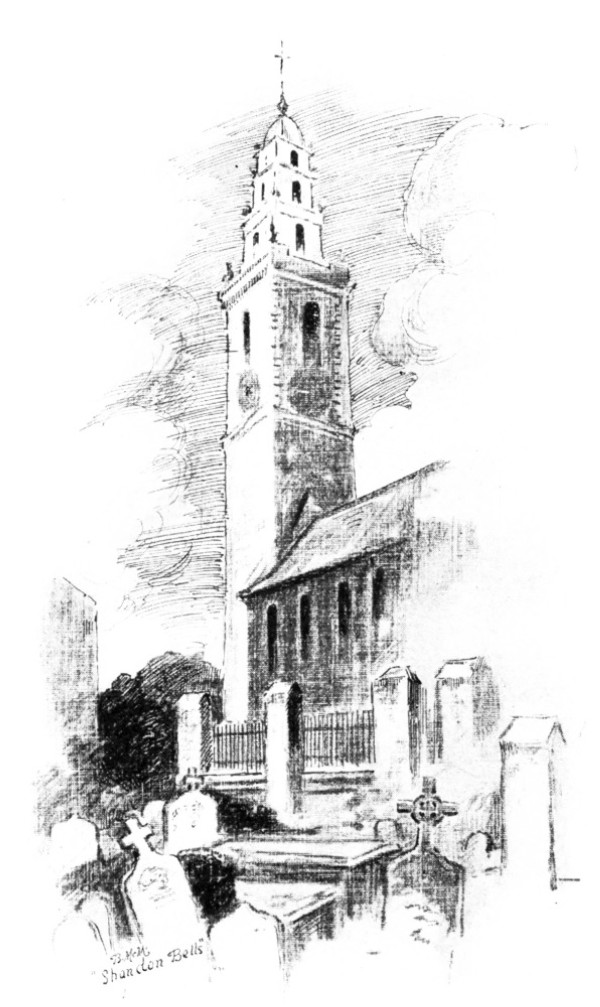 SHANDON CHURCH TOWER. The church was erected on the site of the old Church of Our Lady, or St. Mary Shandon, a very ancient edifice, destroyed at the burning of the suburbs at the siege of Cork by Marlborough in 1690. In the decretal epistles of Pope Innocent III., it is mentioned as the Church of St. Mary in the Mountain. In 1536, the rector of St. Mary’s, one Dominick Tyrrey, was elevated to the see of Cork, of which he was the first Protestant bishop. The Rev. Francis Mahony (“Father Prout”), though he spent much of his life abroad, is buried in the churchyard in the family vault at the foot of the tower. The tower, or steeple, which contains the celebrated bells, is of unique construction. It consists of a tower and lantern (170 feet high) of three stories each. Two sides of the steeple, west and south, are built of limestone, and two, north and east, of red stone. The chime of bells itself does not take a high rank among campanologists, since it is not very excellent either in voice or power. Still, given certain conditions, one may well realize Mahony’s (Father Prout’s) sentiments:
“With deep affection
And recollection I often think on Those Shandon bells, Whose sound so wild would In the days of childhood, Fling round my cradle Their magic spells. “I have heard bells chiming Full many a clime in, Tolling sublime in Cathedral shrine; While at a glib rate Brass tongues would vibrate, But all their music Spoke nought like thine.” 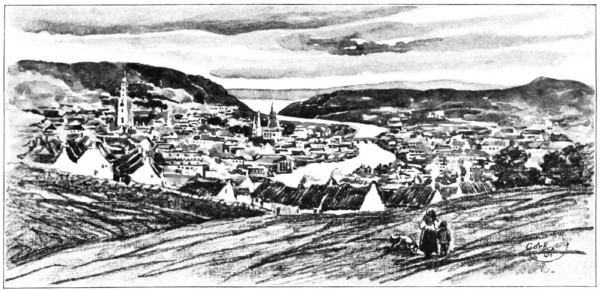 CORK. In the little cemetery of the monastery of the Christian Brothers, near by, rest the remains of Gerald Griffin, the novelist and poet, author of “The Colleen Bawn.” The history of Cork is too vast to chronicle here, but its interest lies rather with the more or less fragmentary recollections, which all of us have, of the traditions and legends of its environment. In the ninth century Cork was frequently plundered by the Danes, who, in 1020, founded, for purposes of trade, the nucleus of the present city. At the time of the English invasion it was the capital of Desmond, King of Munster, who did homage to Henry II., and resigned the city to him. For receiving Perkin Warbeck, the pretender to the throne of England, with royal honours in 1493, the Mayor of Cork was hanged, and the city lost its charter, which was, however, restored in 1609. During the civil war, Cork held out for King Charles, but its garrison was ultimately surprised and taken. When, in 1685, the bigoted and cruel Louis XIV. revoked the Edict of Nantes, Cork, though a Catholic community, opened her friendly arms to welcome the fugitive sons of France, and threw around them the mantle of her protection. The name of St. Finbarr, the first Bishop of Cork, is so commonly referred to in connection with Southern Ireland that it is perhaps allowable to extract and reprint here, from Butler’s “Lives of the Saints,” the leading events of his life: “Called by some St. Barrus, or Barrœus, he was a native of Connaught, and instituted a monastery at Lough Eirc, which lake, said the antiquarian Harris, was the hollowed basin in which the greater part of the city of Cork now sits. From this monastery and its immediate surroundings grew up the present city of Cork. St. Finbarr’s disciple, St. Colman, founded the see of Cloyne, of which he became first bishop. St. Nessan succeeded St. Finbarr at the monastery and built the town of Cork. (This saint, too, is honoured, locally, on the 17th of March and 1st of December.) “The name under which St. Finbarr was baptized was Locahan, the surname Finbarr, or Barr the White, was given to him afterward. He was Bishop of Cork seventeen years, and died at Cloyne, fifteen miles distant. His body was buried in his own cathedral at Cork, which bears his name, and his reliques, some years after, were put in a silver shrine and preserved in the same edifice.” The Abbey of St. Finbarr was a veritable outpost of Christianity. Dungarvan owes its name, and Waterford its Christianity, to Brother Garvan of this abbey; while Brother Brian became the patron of St. Brienne in France. Cork University was a glorious institution in its time, and many who had no prejudices in favour of Ireland have endorsed its virtues from the times of Johnson to those of Newman, Hallam, and Macaulay. After the fall of the Western Roman Empire the schools and the abbeys of Ireland became famous. “Hither fled the timid for safety, and the leisured for learning.” Students came from all lands and teachers went out to all lands. England’s Alfred came here to study, and Charlemagne drew his teachers from this “school of the West,” as it was afterward called by Johnson. One ancient scrivener writes that at this period nearly all the learned were under the influence of Ireland. The great universities of Oxford, Paris, and Pavia, if not actually of Irish inception, were greatly indebted to the learning which spread forth from the Green Isle. There is scarcely a Continental centre of learning, from Palermo to Bruges, or from Grenada to Cologne, where some Irish saint, patron, or monkish scholar is not known and revered. Cork should be endeared to Americans by reason of the association with the city of two whose names will never be forgotten — William Penn, the Quaker, and Father Mathew, the great temperance advocate. In proof of the successful labours of the latter, a great writer of his time stated that not a single instance of drunkenness came under his observation during a sojourn of some weeks in Southern Ireland. It is a happy change from the rollicking recklessness of the ould Ireland of the fictionists and comic-song writers, which, let us hope, has gone for ever, if it ever existed. Father Mathew is buried here, in St. Joseph’s Cemetery, and a bronze statue to his memory stands in Patrick Street. 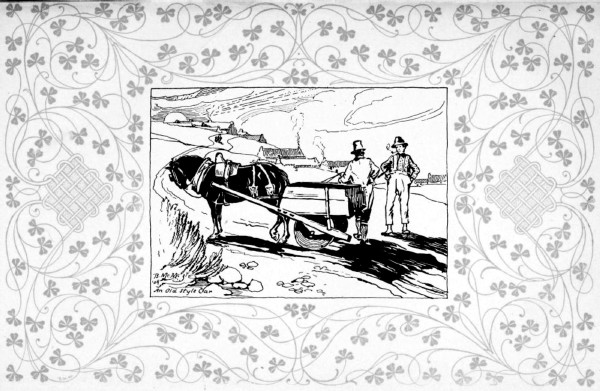 An Old-Style Irish Car Cork is a picturesque and interesting old city. Its churches are mostly modern; but St. Finbarr’s Cathedral stands on the site of a very old and famous church, and is itself a fine building. Cork is one of the principal places where the genuine Irish cloak is at home, and most picturesque it is, though few of the younger women of to-day affect it. For the most part, the girls wear the universal shawl, draped over head and shoulders. The cloaks worn by the matrons and elderly women are great full-length wraps of a black or dark-blue cloth, with a wide hood. Rumour has it that they cost from five to ten pounds apiece, and last, literally, from generation to generation, being sometimes passed down as an heirloom from mother to daughter for half a century. There is a factory for the manufacture of these capes at Blarney, not far from the celebrated castle, and the product finds a large sale among lady visitors who like to spin along the roads at thirty miles an hour, and feel it unbecoming to wear the hideous motor-cap and mask of fashion. Cork abounds in “cars” of all degrees of decrepitude and luxuriousness. The Irish jaunting-car is much more a real accessory of Irish life than the shillalah or the shamrock. In Wicklow one finds the cars more numerous than elsewhere; in the west they are the most decrepit, and in Dublin the most luxurious; but in Cork, of all centres of population, they appear to be the most in use. There has been considerable fun poked at them. They are certainly not beautiful, comfortable, or magnificent, and their drivers, like the “jarvies,” “cabbies,” and “cochers” of other lands, are a species apart from all other humanity. In some parts of the country it is compulsory that the name of its owner, usually the driver, be legibly written on the tailboard of every car. This led to the story which Punch, if it did not invent, at least promulgated, that an inspector, who asked Pat what he meant by having his name obliterated, was met with the reply: “Ye lie, sor; it’s O’Brien.” There are two distinct varieties of car in Ireland, quite apart from the tourist caravans, char-à-bancs, and omnibuses in which visitors are whirled between the beauty-spots of Erin’s leafy glades. The characteristics of each are plainly noted in the “inside cars” of Cork — practically extinct elsewhere — and the “outside cars.” 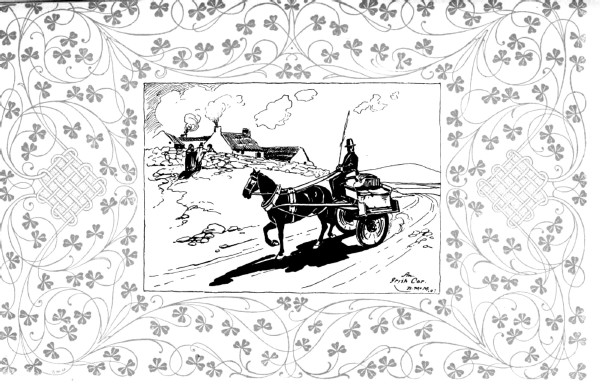 A Modern Irish Car Seated in the indescribable native vehicle of Cork, which whirls one through the town with unexpected lightness and speed, you converse with the affable driver through a small hatchway, open in fine weather and closed in wet, and flanked on each side by a glass port-hole. If you ask for an explanation of the difference between the two varieties of cars, the driver will most likely reply: “The difference between the two cyars, is it? That’s simple, yer honour. Sure, the outside cyar has the wheels inside, and the inside has them outside, as ye see!” Since Blarney, the castle, and the lake are practically a suburb of Cork, they should be considered therewith. Blarney Castle — which is situated, as the native says, “a long mile from the railway station” — is of interest more because it is an exceedingly good specimen of mediæval castle building than because of the notoriety of what Father Prout was pleased to call an “impudence-conferring” stone. As a sentiment or superstition, the alleged incidents or circumstances connected with the “Blarney Stone” are harmless enough; but far more importance has been given to its rather negative charms than is really justified. Blarney Castle itself, with its surrounding “groves of Blarney which look so charming,” and its real and tangible fabric, is of vastly appealing interest; but, usually, it has faded into insignificance in the eyes of those who contemplate the setting which has been given to the all-powerful block of stone. The glib tongue of the native has done much to perpetuate the tradition that whoever kisses it — and accompanies the act with persuasive eloquence, so perceptible in all the folk around about Cork Harbour — is for ever endowed with blessings innumerable, if not actually with superhuman power. The “real stone,” which bore the inscription, “Cormac MacCarthy Fortis Mi Fieri Fecit, A.D. 1446,” now untraceable, or at least illegible, was at the north angle. It was clasped by two iron bars to a projecting buttress at the top of the castle, several feet below the level of the wall, so that, to perform the kissing feat in ancient times, it was necessary to hold on by the bars, and project the body over the wall. The candidate for Blarney honours to-day will find another “real stone,” bearing the date 1703, and clasped by two iron bars, placed within the tower, where it is quite accessible. The “Reliques of Father Prout” contain this allusion to the “Stone:”
“There is a stone
there,
That whoever kisses, Oh! he never misses To grow eloquent. ’Tis he may clamber To a lady’s chamber, Or become a member Of Parliament. “A clever spouter He’ll sure turn out, or An out and outer, To be let alone! Don’t hope to hinder him Or to bewilder him, Sure he’s a pilgrim From the Blarney Stone.”
The pleasure-grounds surrounding the castle, which were formerly adorned with statues, grottoes, alcoves, bridges, and every description of rustic ornament, are still very beautiful, although it is true that:
“The muses shed a tear,
When the cruel auctioneer, With his hammer in his hand, to sweet Blarney came.” And so their beauty has gradually diminished, and the fine old trees have been felled, and one looks in vain for the statues of —
“The heathen gods,
And nymphs so fair, Bold Neptune, Plutarch, And Nicodemus, All standing naked In the open air.” As Father Prout further says, the —
“ ... gravel walks
there
For speculation And conversation” — are still in good order,
and to wander in —
“The Groves of Blarney . . . . . . . . . . Down by the purling Of sweet silent streams,” and among the —
“ ... flowers that
scent The sweet fragrant air” — is a most pleasant occupation for a summer’s afternoon. Blarney Castle was built in the fifteenth century by Cormac MacCarthy, and consists, to-day, of only the massive donjon tower, perhaps 120 feet in height, and another lower portion, less substantial, though hardy enough to warrant the conjecture that, before the introduction of firearms, it must have been impregnable. It is almost as marvellous as the power attributed to the Blarney Stone that a few lines of rather cheap doggerel, containing in themselves no merit save their absurdity, should succeed in gaining a world-wide notoriety for a place which, otherwise, might not have been greatly celebrated beyond its own neighbourhood. It is altogether incomprehensible to the writer that the real charm and romance of this castle, standing up in its fifteenth-century sternness amidst one of the greenest and most smiling districts in all green Erin, have been so obscured, of late, by the popular and vulgar traditions which are perpetuated in the horse-play of holding one another head downwards over the battlements to “kiss the stone,” though this is no longer really necessary, since another more conveniently placed stone has been provided for the purpose. It is a procedure which creates much excitement among a certain class of “trippers,” and, as it keeps a certain amount of coin in circulation in the neighbourhood, it may be accounted as a perfectly legitimate enterprise in that no actual harm is done. What a pity it is, though, that Ireland has no commission for the care of historical monuments, as has France! Macroom, i. e., the Plain of Croom between Cork and Killarney, was once the home and gathering-place of the famous song-bards of the ancients, the druids.
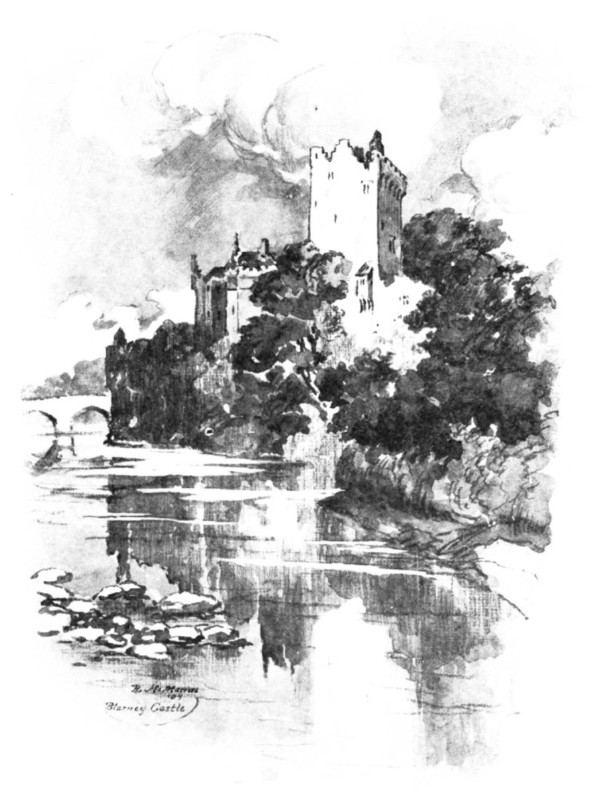 BLARNEY CASTLE. Certainly the druids left a considerable impress upon Ireland, as they did upon Wales and Bretagne; though it may be questioned to-day, in the light of the latest information concerning the druidical race, if their strains of melody actually did pale the cheek of beauty, or even “rise the slumbering passion of the warrior to slaughter.” Macroom, to-day, is chiefly famous for its castle. It was built by the Carews in the time of King John, shortly after the Conquest, and was subsequently in the possession of the MacCarthys. It was burned in the rebellion of 1641. The huge square keep, now covered with ivy, is all that remains of the original structure. Admiral Sir William Penn, father of the founder of Pennsylvania, was born here. Macroom, the centre of the sporting gentry of Muskerry, for whom this barony was always famous, can also boast of a band of poets racy of the soil. In 1774, the poems of John Connolly, a Macroom man, were published in Cork. He thus sings the praises of his native town:
“Whoever means to shake
off gloom
Let him repair to sweet Macroom, For here his cares he will entomb And think no more of sorrow. “Let Mallow yield to gay Macroom, For here we know not care nor gloom, Here nature wears perpetual bloom, And quite dispels our sorrow.” Near Macroom are the celebrated Inchigeela Lakes and the still more celebrated island and lake of Gougane Barra, the retreat of St. Finbarr, who had truly an eye for the beautiful and grand when he chose such a site as this for his meditations. On the verdant islet are the ruins of the little church, and the arched praying-stations of the pilgrims to the shrine. A holy well is also here, and its primitive materials and rude masonry indicate, at a glance, the centuries that have passed since here dwelt the “Island Saint” and anchorite, the founder of Cork. Of the many venerable anchorites who afterward occupied the dwelling, and imitated the virtues of St. Finbarr, the last was Father Denis O’Mahony, whose tomb, erected by himself in 1700, is still to be seen.
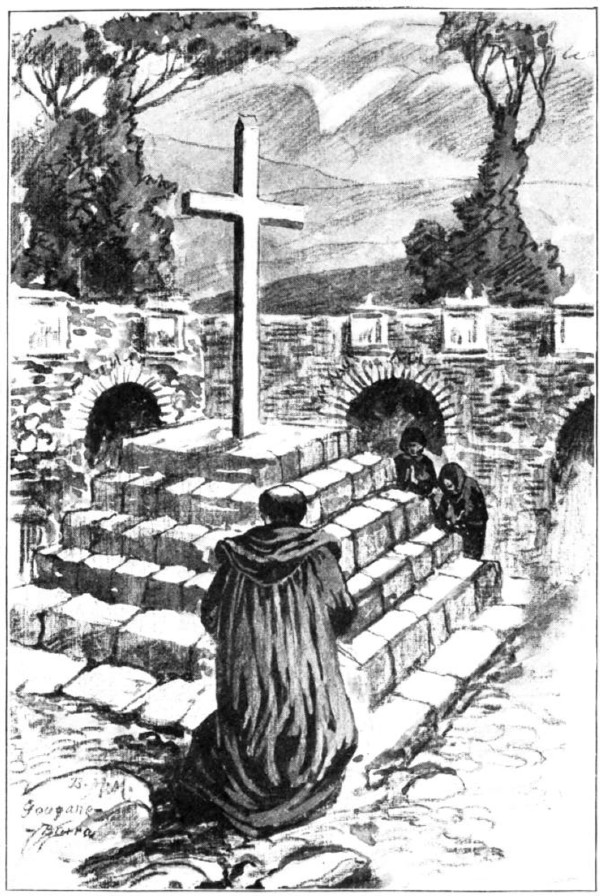 GOUGANE BARRA. Westward, near the border of the lake, is the “Green Valley of Desmond,” enclosed by towering mountains, from the side of one of which, “Nad-na-nillar” (the Eagle’s Nest), flows the tiny source of the river Lee, which runs through Cork to the sea. Here one fully appreciates the appellation, “Lone Gougane Barra.” Callanan, the native bard, has sung of it as follows:
“There is a green
island in Lone Gougane Barra,
Where Allua of songs rushes forth as an arrow; In deep-valleyed Desmond a thousand wild fountains Come down to that lake from their home in the mountains. There grows the wild ash, and a time-stricken willow Looks chidingly down on the mirth of the billow, As, like some gay child, that sad monitor scorning, It lightly laughs back to the laugh of the morning. And its zone of dark hills — oh! to see them all bright’ning When the tempest flings out its red banner of lightning, And the waters rush down, ’mid the thunder’s deep rattle, Like clans from their hills at the voice of the battle. And brightly the fire-crested billows are gleaming, And wildly from Mullagh the eagles are screaming; Oh, where is the dwelling in valley or highland So meet for a bard as this lone little island! . . . . . . . . . . . . . Least bard of the hills, were it mine to inherit The fire of thy harp, and the wing of thy spirit, With the wrongs which like thee to our country has bound me, Did your mantle of song fling its radiance around me. Still, still in those wilds may young liberty rally, And send her strong shout over mountains and valley, The star of the west may yet rise in its glory And the land that was darkest be brightest in story. I, too, shall be gone, but my name shall be spoken When Erin awakens, and her fetters are broken; Some minstrel will come in the summer eve’s gleaming When Freedom’s young light on his spirit is beaming, And bend o’er my grave with a tear of emotion, Where calm Avon Buee seeks the kisses of ocean, Or plant a wild wreath from the banks of that river O’er the heart and the harp that are sleeping for ever.” |